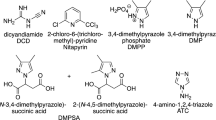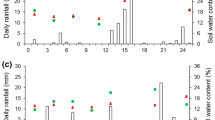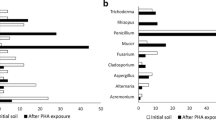Abstract
Ammonia volatilization losses from urea applications are particularly high when urea is not mixed well into soils. These losses have been shown to be reduced by use of urease inhibitors, but as yet there has been no commercial development of these materials. The effectiveness of urease inhibitors formed by the thermal polymerization of phosphoryl triamide (PTA) and thiophosphoryl triamide (TPTA) was investigated under carefully controlled experimental conditions. The PTA-derived thermal polymers showed less apparent urease inhibitory activity than phenyl phosphorodiamidate (PPDA) but were nearly equal or slightly better than PTA itself. The TPTA-derived polymers were significantly better urease inhibitors than their PTA-derived counterparts. Several of the PTA-derived products had greater persistence than PPDA. The urease inhibition in soils indicated that the optimum chain length for these polymeric inhibitors may be from two to four.
Similar content being viewed by others
References
Bremner JM and Mulvaney RL (1978) Urease activity in soils. In: Burnes RG (ed) Soil Enzymes, pp 149–195. Academic Press, New York
Douglas LA and Bremner JM (1970) Extraction and colorimetric determination of urea in soils. Soil Sci Soc Am Proc 34: 859–862
Douglas LA and Bremner JM (1971) A rapid method of evaluating different compounds as inhibitors of urease activity in soils. Soil Biol Biochem 3: 309–315
Gautney J, Kim YK and Gagen PM (1984) Feasibility of cogranulating the nitrogen loss inhibitors dicyandiamide, thiourea, phenyl phosphorodiamidate, and potassium ethyl xanthate with urea. I&EC Chem Prod Res Dev 23: 483–489
Gautney J, Kim YK and Barnard AR (1985) Solubilities and stabilities of the nitrogen loss inhibitors, dicyandiamide, thiourea, and phenyl phosphorodiamidate in fluid, fertilizers. I&EC Chem Prod Res Dev 24: 155–161
Gautney J, Barnard AR, Penney DB and Kim YK (1986) Solid-state decomposition, kinetics of phenyl phosphorodiamidate. Soil Sci Soc Am J 50: 792–797
Radel R J (1986) Thiophosphoryl triamide as a urease inhibitor. Statutory Invention Registration No. H-25
Goering M and Niedenzu K (1956) Phosphorus-oxygen compounds. Part I: The synthesis of the amides of phosphoric acid and thiophosphoric acid. Chem Ber 89: 1768–1771
Kolc JF, Swerdloff MD, Rogic MM, Hendrickson LL and Van Der Puy M (1985) N-Aliphatic and N, N-Aliphatic Phosphoric Triamide Urease Inhibitors and Urease Inhibited Urea Based Fertilizer Compositions. U.S. Patent No. 4,530,714
Nelson DW (1982) Nitrogen in Agricultural Soils. American Society of Agronomy, Madison, Wisconsin. pp 327–358
Radel RJ, Randle AA, Gautney J, Bock BR and Williams HM (1992) Thiophosphoryltriamide: A dual purpose urease/nitrification inhibitor. Fert Res 31: 275–280
Author information
Authors and Affiliations
Rights and permissions
About this article
Cite this article
Radel, R.J., Randle, A.A. & Kim, Y.K. Soil urease inhibition by thermal polymers of thioposphoryl triamide and phosphoryl triamide. Fertilizer Research 39, 153–160 (1994). https://doi.org/10.1007/BF00750914
Received:
Accepted:
Published:
Issue Date:
DOI: https://doi.org/10.1007/BF00750914




